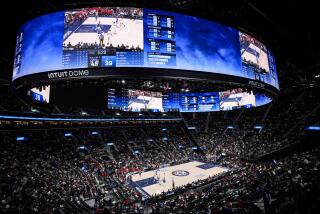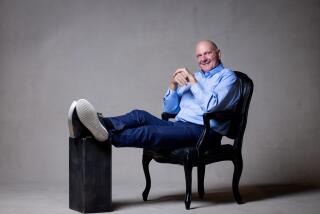FEELING LIKE A BILLION
- Share via
KIRKLAND, Wash. — Turns out, the team stayed but the controversial owner and the high-priced quarterback didn’t.
This is the strange and contorted story of a real estate developer who thought his and the franchise’s destiny was in Southern California, a software billionaire who can buy whatever destiny he chooses, a nail-biting June statewide vote, millions of public dollars, a star-struck quarterback and an apathetic town that used to go bonkers for the Seahawks.
“Oh, this was a Seahawk town,” said John Nordstrom, who led the local ownership group that sold the team to real estate magnate Ken Behring in 1988. “It really was.”
By February 1996, it wasn’t.
After years of Seahawk mediocrity and Behring’s open desire to flee to a drier, more lucrative climate, it was a Mariner town. And a SuperSonic town.
After the Northern California-based Behring announced his intention to move the team to L.A.--then took the Seahawks to Anaheim for a bizarre, are-they-here-or- aren’t-they? two-week mini-camp at the abandoned Ram facility in March 1996--Seattle was an almost-former NFL town.
Then in stepped Microsoft co-founder Paul Allen, and things changed fast.
Over the last 18 months, the Seahawks have traded the unpredictable Behring for Allen as owner, the maligned Rick Mirer for fan favorite John Friesz at quarterback, and the possibility of moving to L.A. for a long-term commitment to stay in Seattle, as long as the Kingdome is blown up ASAP and replaced by a shiny new $400-million-plus super stadium.
Along the way, turbo-boosted by Allen’s quick-trigger off-season signings of star linebacker Chad Brown and defensive backs Willie Williams and Bennie Blades and the trade of Mirer to Chicago for a first-round pick, the Dennis Erickson-coached team has gotten deep and dangerous.
“Oh, there’s no question,” said assistant coach Jim Zorn, whose bombs to Steve Largent almost two decades ago are hallowed moments from the team’s glory days, “this team would crush our team.
“I don’t think they would beat us in enthusiasm, but you don’t only win with enthusiasm.”
In these days of free agency and salary-cap economics, you win with a canny use of cash flow and with stability from the top.
And, given the jump-start Allen and his team president, Bob Whitsitt, have provided and the cutthroat moxie they displayed in their campaign to get voter approval for their new stadium, the Seahawks may be tough to top.
“His whole organization will feed the attitude of the players,” said punter Rick Tuten, who is beginning his seventh season with the Seahawks. “If it’s something that’s going to help the team and the organization, they just do it--because they can.”
For now, the response hasn’t been overwhelming--after almost two decades of solid sellouts then the recent plunge, season tickets are up about 8,000, from a low of 36,000 last season.
But Whitsitt says he understands that restoring the passion will be a long-term process. Which is why the signings of Brown (who got a $7-million bonus) and the rest were so pivotal, he says.
“If the choice is between cautious or aggressive, we’ll be aggressive--not stupid, but aggressive,” Whitsitt said. “We wanted to figure out who we wanted and go get them. Not get what’s left over. Dennis and Randy [Mueller, the team’s vice president for football operations] and the guys figured out who they wanted and boom, they got them.”
Suddenly, after 8-8 and 7-9 records in Erickson’s unsettled first two seasons, this is a team comfortable with its quarterback and not wondering where its owner is going to head to next.
“All you want is a chance to win and a chance to be successful,” said Erickson, who was lured to the Seahawks from the University of Miami by the prospect of returning to his home community. “And Paul will give us that chance.”
“This has been,” said Nordstrom, who served as liaison between the NFL and Allen, “about as dramatic a turnaround as you’ll ever see from one year to another for a professional sports team.”
Allen, urged on by community leaders, got involved in April 1996, when it became clear that Behring’s planned move to L.A. was hitting major snags.
For a reported nonrefundable $20 million, Allen bought a 14-month option to decide whether he wanted to buy the franchise, and declared that if a deal could be created to build a new stadium (Allen said he would pay $100 million of the stadium price), he would take the Seahawks off Behring’s hands permanently.
After much wrangling and charges by both the politicians and by Allen’s group that the other side was being intractable in negotiations, the stadium issue was put to a vote--not long after the Mariners’ new $300-million-plus stadium was defeated by voters, then revived by a vote in the state legislature.
Understanding that voters were weary of footing the bill for yet another sports stadium, Allen poured as much as $7 million into a widespread campaign--
including a barnstorming tour led by former coach Chuck Knox, who is still widely admired in the state--slyly dubbed as Allen’s “Morning in America” blitz by populist Seattle Times columnist Ron Judd.
“I think there’s definitely lingering bitterness about how this came about,” said King County councilwoman Maggie Fimia, who was a passionate opponent of the stadium plans. “People voted for it under the guise that it wouldn’t cost them anything in taxes, but they’re realizing all it did was transfer the taxes to the state . . .
“I guess if you pump $6 or $7 million dollars of advertising in a four-week period, you can convince anybody of anything.”
The referendum passed 51% to 49%, losing badly in the eastern part of the state but winning easily in the three counties in and around Seattle. And Allen assumed official control of the Seahawks.
“We had to pass legislation to loan them about $360,000 that they will supposedly pay back,” said Fimia, who has received a few death threats for her stance. “So they’re already coming back to us. This is somebody who has what, $11 billion, and needs a loan from the county for $360,000 to get him through?”
This summer, the Seahawks made another symbolic and logical move to reconnect with their fan base: moving their training camp out of their Kirkland compound--which is tucked in the middle of a residential neighborhood outside Seattle and is closed to the public--to Cheyney, Wash., a four-hour drive east into the state’s farming lands, where the Seahawks trained in their first decade of existence.
“To see all the fan support we had every day in practice, it was nuts,” Tuten said. “It was like when I used to be in Buffalo-- there were hundreds of people every day, wanting autographs and just wanting to be there and see the Seahawks practice.
“That means a lot to the team. Because you don’t feel like you’re standing on a mountain. There were games last year and the past years that we weren’t playing for a city, we were playing for ourselves. Because that’s the only people who were in the stadium.”
Officials don’t expect a sellout for Sunday’s Kingdome season opener against the New York Jets, predicting a crowd of about 50,000. Bigger crowds, though, may arrive if the team starts the season successfully.
“I don’t think it’ll be very hard to get that back,” Nordstrom said. “I think Paul and Bob Whitsitt are exactly the right combination to win the fans back. And I think it’ll happen quicker than anybody realizes.”
More to Read
Go beyond the scoreboard
Get the latest on L.A.'s teams in the daily Sports Report newsletter.
You may occasionally receive promotional content from the Los Angeles Times.










